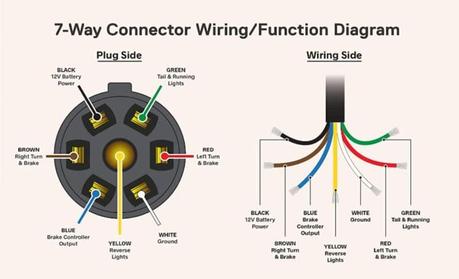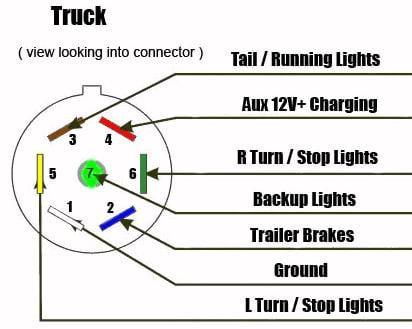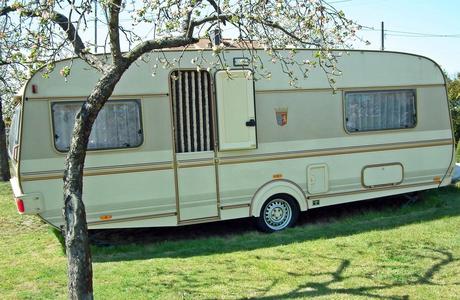Towing a trailer can be daunting, but with the right know-how, it becomes straightforward. The heart of the matter lies in the connection between your vehicle and trailer, which is often facilitated by a 7-pin trailer plug. This component ensures that your trailer’s lighting and braking systems operate in sync with your vehicle, enhancing road safety.
Importance of Properly Connecting Your 7-pin Trailer Plug
Correct installation is vital for several reasons. Primarily, it ensures legal compliance as most regions require trailers to have functioning signal lights. Moreover, a well-connected 7-pin trailer plug minimizes the risks of accidents due to signaling errors, which can lead to serious road mishaps.
Signal lights on any vehicle, including recreational vehicles (RVs), serve critical communication functions in traffic. For an RV, which is typically larger and heavier than most other road vehicles, signal lights provide essential indications regarding its intentions to change lanes, turn, or brake. An RV’s larger physical footprint and mass mean that its movements have a proportionally greater impact on the flow and safety of traffic around it. These lights, therefore, play a heightened role in safety for the RV and other road users by signaling the driver’s intentions well in advance, particularly important given the increased distance and time an RV may require to maneuver or come to a complete stop.
Furthermore, signal lights on RVs help compensate for the reduced visibility that drivers of smaller vehicles face when in close proximity to larger ones. RVs have significantly larger blind spots, which make it difficult for other drivers to anticipate an RV’s movements without the appropriate signaling. Effective communication through signal lights is essential to navigate these blind spots and prevent collisions.
In addition, given that RVs are often used for vacationing and may traverse a variety of roadways, from highways to rural areas, having a reliable signaling system ensures that the vehicle can adequately interact with a diverse range of traffic conditions and local driving behaviors. Signal lights, therefore, are integral not just for compliance with traffic laws but also for maintaining a predictable and orderly flow of traffic, which is crucial for overall road safety.
Benefits of Knowing How to Wire Your 7-pin Trailer Plug Correctly
Understanding the wiring process saves you from potential fines and provides peace of mind. It allows for quick setup and troubleshooting, ensuring that your trailer is always ready to hit the road without any electrical hiccups.
Tools and Materials You’ll Need
List of Tools
To get started, gather these essential tools: a wire stripper, a screwdriver set, a voltage tester, and pliers. These will help you prepare the wires and ensure secure connections.
Types of Wires Required
The wires you’ll need should correspond to the pins’ functions. Typically, these include ground, tail lights, left and right turn signals, electric brakes, reverse lights, and a 12V power supply. Opt for color-coded wires to avoid confusion during the installation process.
When looking for wires for the seven pins used for RV connectors, it’s important to consider the requirements for these connections, which typically include running lights, ground, brakes, left and right signals, and power. These connectors establish an electrical connection between the RV and a towing vehicle.
To source the appropriate wires for a 7-pin RV connector, you can explore the following options:
- Automotive parts stores: Stores that specialize in automotive parts and accessories commonly stock wiring kits and individual wires that are suitable for 7-pin RV connections. These will typically be wires that are designed to handle the electrical load and external environment.
- RV dealerships or supply stores: Dealerships selling RVs or stores specializing in RV parts and accessories will have the necessary wiring for 7-pin connectors. They may also offer complete kits with wires and connectors.
- Online retailers: There are numerous online platforms where you can find 7-pin wiring kits. These retailers range from dedicated RV accessory sites to larger e-commerce platforms. Ensuring that the wires are rated appropriately for RV use is crucial.
- Trailer supply shops: Stores that specifically cater to trailers and towing will have compatible wiring for 7-pin RV connectors. These shops usually have options for both kits and individual components, enabling custom setups.
- Specialty electronic suppliers: You might also find suitable wires at suppliers that cater to automotive and specialty electronics.
Remember to consider the wire gauge, insulation type, quality, and the ratings necessary for the specific electrical demands of an RV connector. Compatibility with your RV and towing setup in terms of length and flexibility of the wires, as well as the environmental resistance required (such as water and abrasion resistance), is essential to ensure safety and functionality.
Step-by-Step Guide to Wiring Your 7-pin Trailer Plug
Identify the Functions of Each Pin
Begin by familiarizing yourself with the pin layout. Standard configurations assign specific functions to each pin. For example, the center pin usually powers the reverse lights, while others handle brakes, battery charging, and ground.

The Specific Functions of Each Pin
A 7-pin trailer plug, also known as a 7-way trailer connector, is a common interface used to connect a tow vehicle to a trailer. It serves several functions related to power supply, signaling, and auxiliary functions necessary for safe towing.
Pin 1 is usually assigned to the left-hand turn signal. It’s typically denoted by a yellow wire, which carries the current for this function. The signal for the left turn is essential for safe towing operations, allowing other road users to anticipate the trailer’s movements. This is especially important because the turn signals on the towing vehicle may be obscured by the trailer itself, so the trailer’s turn signals must be clear and fully operational.
Pin 2 is generally used for the right-hand turn signal, often represented by a green wire. Like the left-hand signal, it provides an indication for a right-hand turn or lane change. Its separation from the left-hand signal ensures that each side operates independently and that the turn signals are communicated clearly to those driving behind the trailer. This is critical for maintaining on-road safety and avoiding potential accidents.
Pin 3 is for the taillights, including the license plate illumination, and is usually designated with a brown wire. This function ensures that the back end of the trailer is visible at night or in poor visibility conditions. Good visibility of the trail end is essential for safety to aid other road users in gauging the trailer’s position and dimensions when visibility is low. This includes the continuous illumination that marks the trailer’s presence on the road and the lighting that illuminates its license plate, which is legally required to be visible.
Pin 4 serves the brake lights and is customarily marked by a red wire. When the driver of the towing vehicle applies the brakes, this signal activates the brake lights on the trailer, thus alerting drivers behind the trailer to decelerate or stop. The brake light function is arguably one of the most crucial safety features, signaling a reduction in speed and the likelihood of a stop, thereby helping to prevent rear-end collisions.
Pin 5 is often allocated for the electrical braking system and is often identified by a blue wire. Most trailers that use a 7-pin trailer plug have their own braking systems, which can be electronically controlled from the towing vehicle. This function is essential for maintaining control of the trailer, particularly in heavy trailers or under conditions where the trailer’s momentum may significantly influence the towing vehicle’s braking capabilities, such as when driving downhill.
Pin 6, connected via a red or black wire, is commonly used to supply a 12-volt power line to the trailer. This power can be used to charge batteries in the trailer, power interior lights, or run appliances within the trailer when it’s not connected to an external power source. This feature enhances trailer functionality, especially in living or camping situations where autonomous power is valuable.
Lastly, Pin 7 is utilized for backing up lights and is usually connected by a purple or pink wire. This function activates the trailer’s reversing lights, which inform other drivers that the towing vehicle is moving backward and also provide illumination to assist with backing up maneuvers. The reverse lights are particularly helpful when reversing in dimly lit areas, enhancing safety by increasing visibility for the driver and alerting pedestrians and other vehicles to the trailer’s movements.
Strip Wire Insulation
Next, using your wire strippers, strip approximately half an inch of insulation from the end of each wire. This will expose the metal conductor that must contact the respective pin.
Stripping wire insulation requires care because, if improperly conducted, the process can damage the conductive material of the wire itself, potentially leading to electrical malfunctions or shorts, which can cause equipment failures or even pose a fire risk. Additionally, the sharp tools used, such as wire strippers or knives, can cause personal injury if not handled correctly. It is also important to ensure that the exposed wires do not create an electrical hazard by inadvertently coming into contact with conductive materials or being within reach of individuals who might unknowingly touch them.
Here is how to properly strip wire insulation for RVs:
- Select the appropriate tool for the wire size being stripped – this could be an automatic wire stripper, a manual wire stripper, or a specialty tool for certain types of wire.
- Adjust the tool to match the gauge of the wire to ensure that only the insulation is cut without nicking the wire strands.
- Securely hold the wire in one hand and the tool in the other hand.
- Place the wire within the jaws of the stripper at the desired length from the end to be stripped.
- Squeeze the tool handles firmly and evenly so the stripper scores the insulation.
- Twist the tool slightly, if necessary, to break the insulation free around the circumference of the wire.
- Pull the tool toward the end of the wire to remove the insulation cleanly, ensuring the wire strands are intact.
- Inspect the stripped wire for nicks or damage and ensure that all necessary insulation has been removed.
- If using a knife or other sharp cutting tool, carefully score around the insulation without applying too much pressure, and then make a lengthwise cut to peel away the insulation.
- Always wear safety glasses to protect your eyes from any small particles or debris that might result from cutting the wire insulation.
Connect Wires to Respective Pins
Attach each wire to its corresponding pin by loosening the screw on the 7-pin trailer plug, inserting the wire, and then tightening the screw to secure it. Be careful not to over-tighten and damage the wire.
Secure Connections
After all the wires are connected, tug gently on each one to ensure they are secure. Use the voltage tester to check for proper connectivity before attaching the 7-pin trailer plug to your vehicle.
Connecting Your 7-pin Trailer Plug to Your Vehicle

Matching Pins to Receptacles
Align the 7-pin trailer plug with the receptacle on your vehicle. The notches should line up, allowing the plug to be inserted smoothly.
Securing the Connection
Once the plug is seated, lock it in place if your receptacle has a locking mechanism. This prevents it from detaching while driving.
When discussing a 7-pin trailer plug that is not locked up properly, it is essential to consider the type of plug in question. Generally, “locking up” a plug can mean ensuring that an electrical connector is securely connected or that a safety mechanism to prevent accidental disconnection is engaged. The consequences of a plug not being adequately secured can include electrical hazards, such as shock or fire, and loss of power to an essential device, which could have further downstream safety or operational impacts, depending on the context.
To double-check that a 7-pin trailer plug is appropriately locked up, one usually follows a procedure to confirm the connection’s physical and electrical stability. This procedure can differ depending on the specific plug and socket design, but there are common steps.
- Visual Inspection: The first step is to inspect the plug and socket to ensure the plug is fully inserted into the socket. For some plugs, aligned markings or an inability to see certain parts of the 7-pin trailer plug that mate with the socket can indicate a full insertion.
- Mechanical Check: Many locking plugs have a mechanism, such as a collar, twist lock, or latch, that clicks or snaps into place, securing the connection. You can usually feel if the locking mechanism is engaged by gently tugging on the plug or trying to rotate it.
- Functional Test: If applicable and safe, testing the functionality of the device or equipment powered by the plug can ensure a stable electrical connection.
- Consult Documentation: If you are uncertain how to secure the 7-pin trailer plug properly, consult the manufacturer’s documentation. It can provide specific instructions on correctly locking the plug and confirming that it is secure.
It is important to ensure that all safety guidelines and manufacturer’s instructions are followed when dealing with electrical components to mitigate the risks of electric shock, fire, or critical equipment failure.
Testing the Trailer Lights
Test all your trailer lights—brake lights, turn signals, and tail lights—to confirm they work in harmony with your vehicle’s lighting system. If any light fails to respond, it indicates a problem in the connection that needs addressing.
Tips for Troubleshooting Common Issues
Checking for Loose Connections
Most issues stem from loose or corroded connections. Inspect each wire to ensure it’s snugly attached to its pin, and look out for rust, which can impede electricity flow.
The typical voltage level for a 7-pin trailer plug-in automotive applications is 12 volts of direct current (DC) on each pin that carries power, conforming to the voltage level of most automotive electrical systems. It’s important to note that this is the nominal system voltage; actual measurements can be slightly higher, especially when the vehicle’s engine is running and the alternator is charging the battery—which can be around 13.8 to 14.4 volts.
The function of each pin on the 7-pin trailer plug generally adheres to a commonly accepted convention:
- Left indicator (yellow wire)
- Rear fog lights (blue wire)
- Earth/ground (white wire)
- Right indicator (green wire)
- Right tail/side light (brown wire)
- Brake lights (red wire)
- Left tail/side light (black wire)
In some versions of the 7-pin trailer plug, there may also be connections for reversing lights and a permanent live wire that could be used to maintain the trailer’s house battery(ies) charge.
The wiring and voltage levels must be checked with a suitable tester before use to ensure that they correspond correctly to each pin and, thus, to the function they are intended to control. Incorrect wiring or voltage levels can lead to malfunctioning trailer lights, potential safety hazards, or damage to the vehicle’s electrical system.
Testing for Proper Functionality
If the lights aren’t working as they should, use a voltage tester to check each pin for proper voltage levels. This helps pinpoint where the issue may lie.
Revisiting the Wiring if Issues Persist
When all else fails, revisit your wiring setup. Double-check that each wire corresponds to the correct pin and that the wires have no shorts or breaks.
How to Test a 7 Pin Trailer Connector with a Multimeter and Troubleshooting my Trailer WiringConclusion
Wiring a 7-pin is a valuable skill that enhances your towing experience. Following this guide teaches you the detailed steps to connect your trailer securely and ensure it communicates effectively with your vehicle. Safe travels!


